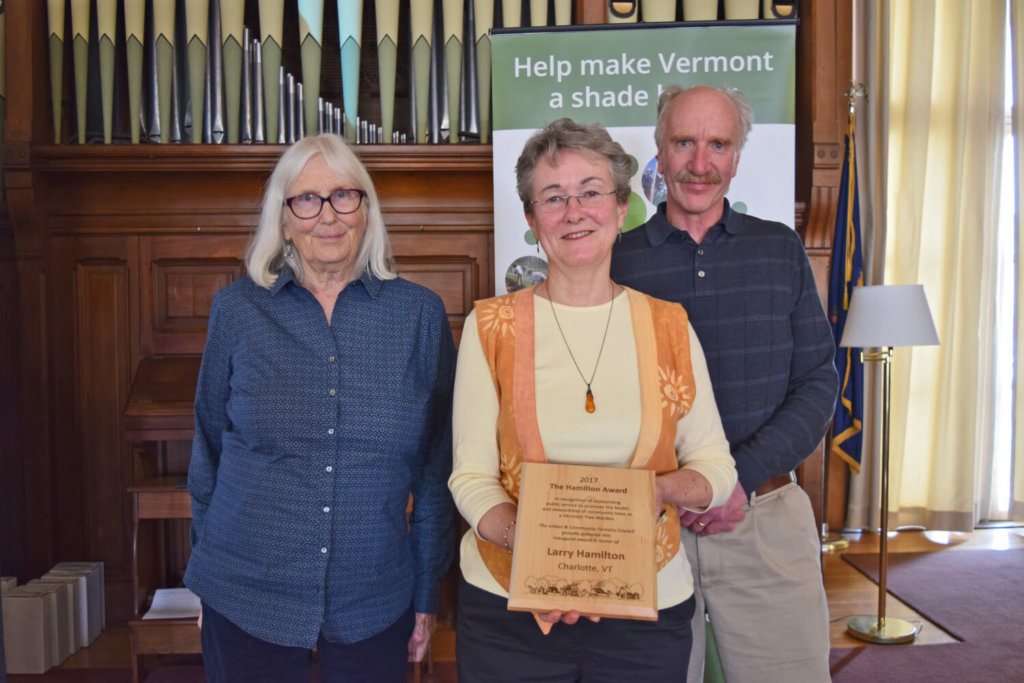Vermont Urban and Community Forestry Program creates Hamilton Award

At the May 4 statewide Arbor Day conference, with the theme “Make Vermont a Shade Better,” the Vermont Urban and Community Forestry Program inaugurated a new award. This adds to its annual recognition of significant tree stewardship efforts with awards to individuals, communities and academic campuses for care of community trees.
The Hamilton Award was created in 2017 in honor of former Charlotte Tree Warden Larry Hamilton, to be presented annually in recognition of outstanding public service to promote the health and stewardship of community trees as a Vermont tree warden. As part of the conference’s annual awards ceremony, Vermont Urban and Community Forestry Program Technical Assistance Coordinator Elise Schadler presented the background of Larry’s long and energetic service as Charlotte tree warden, which included not only tree planting and protection but also an emphasis on community education and engagement. Elise presented Larry’s widow, Linda Hamilton, with the inaugural plaque, in a bittersweet moment for all who had known and worked with Larry.
Dr. Lawrence S. (Larry) Hamilton served as tree warden in the Town of Charlotte, Vermont from March 1996 until his death in October 2016. He enthusiastically volunteered for this role, as a way to apply his forestry, conservation planning and teaching experience to community service.
His love of nature, especially trees, was infectious. By popular demand, he expanded the role of Charlotte tree warden from monitoring and stewarding trees in the road rights-of-way and on other public lands to include a strong educational component. Through a variety of means, he promoted understanding and appreciation of trees as especially important components of the web of life—from the practicalities of carbon dioxide and oxygen exchange to providing home and garden to a myriad of other organisms above and below ground, protecting from wind and sun, and, of course, providing awe, beauty and inspiration. He enlivened Arbor Day with Selectboard declarations and participation in student-assisted planting of a tree each year at Charlotte Central School. A popular leader of nature walks featuring tree identification and forest ecology, he initiated a community project to document Big Trees and Significant Trees in Charlotte on public and private land. He regularly cooperated with the Conservation Commission and served on the Charlotte Park and Wildlife Refuge Oversight Committee. His educational efforts were most visible through the wide-ranging topics of the regular Tree Warden column he wrote for The Charlotte News.
In dealings with landowners, the town road commissioner and utilities workers, Larry established a reputation for fairness and for consistently calling for replacement plantings rather than fines. Having gained the community’s respect and confidence, he was able to successfully raise thousands of dollars from 2006–16 for a roadside tree restoration project. More than 450 trees were planted under his leadership. For ongoing monitoring and maintenance of these, he recruited a cadre of tree keepers and organized a six-session training course for them in 2008. Other volunteers and advisors have also been drawn in to help with technical aspects.
Larry Hamilton’s vision for the tree warden was not a solo act. He saw it as a leadership role to educate and engage more townspeople in the stewardship of trees as important public resources. Because of this vision, Charlotte now has a tree warden, deputy tree warden and an active tree team—all of whom are dedicated volunteers finding rewarding community service with tangible results, as well as opportunities for learning and for fellowship with others who love nature and care about the future of their town.

